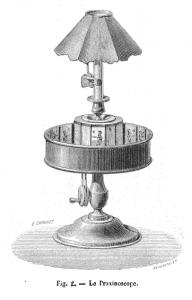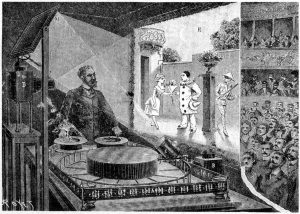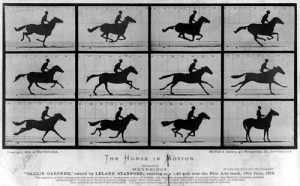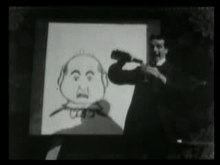The First Animated Film was the result of a period of inventions that inspired 19th and 20th-century pioneers to bring their still drawings to life.

image source:https://en.wikipedia.org/wiki/Praxinoscope#/media/File:Lanature1879_praxinoscope_reynaud.png
Who is Charles-Emile Reynaud?
The inventor of the viewing device called a Praxinoscope (1877), French scientist Charles-Emile Reynaud, became known as the First Motion Picture Cartoonist. He had created a large-scale system called Theatre Optique (1888) which could take a strip of pictures or images and project them onto a screen.

image source: https://en.wikipedia.org/wiki/Praxinoscope#/media/File:Theatreoptique.jpg
First steps

image source: https://search.creativecommons.org/photos/8880a302-f9e3-4f3d-88f6-9c06c4bf04dd
English photographer Eadweard J. Muybridge lay the foundations for a motion picture with his pioneering experiments with moving images. Muybridge’s Animal Locomotion studies involved using twelve thread-triggered cameras, the Zoopraxiscope, and the Phenakistoscope disc.
James Stuart Blackton and Albert E. Smith, founders of Vitagraph Studios, are two of the first artists to use the stop-motion technique in The Humpty Dumpty Circus (1898). Blackton also combined the stop-motion technique with hand-drawn animation in his film, The Enchanted Drawing (1990), which is considered to be the first animated sequence recorded on standard picture film.

image source: https://en.wikipedia.org/wiki/The_Enchanted_Drawing
The world’s first animator though, was probably British-born Arthur Melbourne-Cooper, a cameraman who created the first stop-motion animation film. One of his earliest animations, Matches: an Appeal was made for match-making company Bryant and May.
Matches: An Appeal (1899)
Cooper’s advertisement for matches, sees animated matchstick figures, created by joining matches together with lightweight wire, writing an appeal to the audience on a blackboard, asking them to send money that will go to matches for British soldiers fighting overseas in the Boer War.
Other than being the first animated film to be shown in public, this advertisement is an early precedent of how the animation would go on to be used for advertising and wartime propaganda: it was shown in music halls, fairgrounds, and cinemas, marking the point when animation’s potential to sell messages and products was recognized.

image source: https://en.wikipedia.org/wiki/File:MatchesAppeal.jpg
Info source: https://en.wikipedia.org/wiki/History_of_animation
